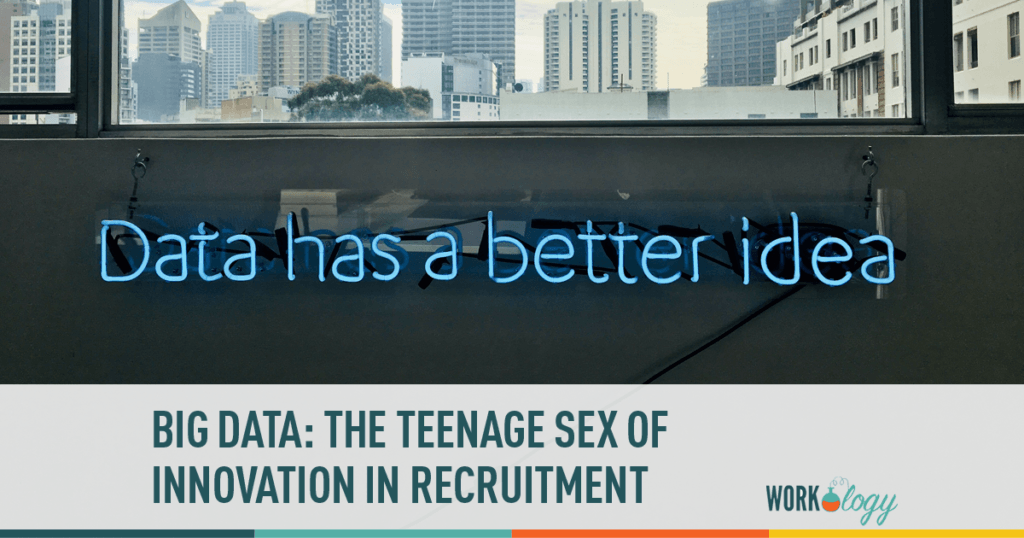This week on Blogging4Jobs, we are focusing on the theme Big Data sponsored by Jibe. Jibe provides cloud-based recruiting technology solutions that enable talent acquisition teams to strategically identify, attract and engage candidates. Join us April 10th 2014 at 3pm to talk Big Data on Twitter using the hashtag #BigDataHR and join our webinar, “What’s the Big Deal with Big Data in HR & Recruiting” on April 17th at 11a EST. Follow the week by bookmarking us!
According to Dan Ariely, TED speaker, best-selling author, and Duke University professor, big data and teenage sex have a lot in common: “Big data is like teenage sex: everyone talks about it, nobody really knows how to do it, everyone thinks everyone else is doing it, so everyone claims they are doing it.”
A recent study by Gartner supports this. According to their survey, while 64 percent of companies plan on deploying a ‘big data’ project, a staggering 56 percent fail to understand how they will get value from the data they are seeking to find.
Big data was supposed to be the new promised land. There is all this data – vast amounts of it – sitting below the surface of our social networks, email exchanges, e-commerce stores; every click, eye ball, search and download request is a tiny piece of this massive untapped resource. Releasing all this data was supposed to be like finding crude oil. Countless wells of the Good Lords’ bountiful black stuff were supposed to be springing up all over the place. Right now, we should be awash with amazing new insights about customers, employees, about life itself, which the miracle of big data should have unearthed. So why aren’t we?
We aren’t, because big data, like teenage sex, is still at that awkward, ‘fumbling in the dark’ stage. No one will be truly satisfied until we all understand what big data is and how it can be used effectively.
Big Data and Recruitment: A Supply Side Problem.
Demand for using big data is high amongst recruitment and HR professionals. The problem is the supply of people who understand: what big data is, and how to use it to recruit, train and retain staff.
Rob Symes, a recruitment consultant was interviewed by best-selling author Michael Lewis, for his book Moneyball, about this very problem. Lewis was trying to apply the same logic used in sports teams to the recruitment sector. Symes’ stated that, “HR people – traditionally – are brilliant for legal, they’re brilliant for motivating people, but they’re not numbers orientated. Only 10% of HR professionals at FTSE 100 firms have a degree in a subject involving statistics – maths, economics, sciences.” Which means, it is all very well and good collecting data on prospective employees. Thanks to Google and LinkedIn we can do so fairly easily. But to what end, if we don’t have people who understand how to get value from all this extra information?
This might be why the US Bureau of Labor Statistics projects a 22 percent increase in people with data-based management analysis skills between now and 2022.
Can Big Data Be Used Effectively In Recruitment?
The answer is yes, providing, as discussed above, those with the right skills are employed in recruitment and HR departments. It comes down to discovery, visualization and insight. Technology can help. As can decreasing the skills gap.
We should remember that big data isn’t a silver bullet, even in recruitment. But it can give companies an edge. “The traditional recruitment model is you recruit an employee, and they either sink or swim. What I’m interested in is using data to [better understand] your workforce, and then training your recruiters, or your whole recruitment system, to seek out those same characteristics”, says Symes.
This means bringing together information before you hire applicants (e.g. pre-employment screening) with data from an employees’ time with a company (e.g. performance, sick days, even blood sugar, mental alertness, happiness, etc.) in order to know more about their strengths, weaknesses, what motivates them, what will help them be better employees.
Collect enough data points from enough employees, collate it, analyze and interpret the knowledge and you could spot insights you didn’t have before. You can base new initiatives, new products and services, and new hiring and training practices on facts, rather than subjective theories. Thereby saving money and improving the bottom line. That is where the true hidden value is within our digital oil wells of big data. Not from snazzy reports and sentiment analysis, but from having a more complete understanding of your greatest assets: your staff.










One Comment
Grammatical errors throughout aside, this is a truly awful analogy. I understand clicks and social media shares are the new currency, but comparing anything to teenage sex is embarrassing and shameful. I regret giving my time and attention to it, but I like to think people in this profession are better than these kinds of analogies. Are we trying to start dialogues and action or incite clicks? Sadly, it looks to be the latter.
Comments are closed.